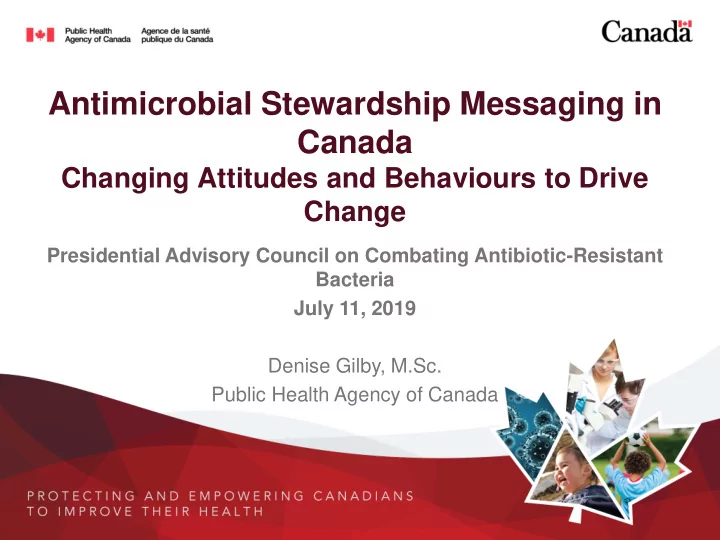

Antimicrobial Stewardship Messaging in Canada Changing Attitudes and Behaviours to Drive Change Presidential Advisory Council on Combating Antibiotic-Resistant Bacteria July 11, 2019 Denise Gilby, M.Sc. Public Health Agency of Canada
Key Messages • Understanding the K nowledge, A ttitudes and B ehaviours of patients, prescribers, dispensers and the general public is essential for effective antimicrobial stewardship (AMS) messaging. • Messaging needs to be tailored to address the drivers of unnecessary use of antimicrobials- recognizing the social and cultural factors relevant to the target population. 2
Public Health Agency of Canada The Public Health Agency of Canada is a Canadian government institution that is part of the Health Portfolio, under the leadership of the Minister of Health. Mandate • Promote health; • Prevent and control chronic diseases and injuries; • Prevent and control infectious diseases; • Prepare for and respond to public health emergencies; • Serve as a central point for sharing Canada's expertise with the rest of the world; • Apply international research and development to Canada's public health programs; and • Strengthen intergovernmental collaboration on public health and facilitate national approaches to public health policy and planning. 3
The Canadian Context • Canada has a federated, publicly funded health care system. • Health care services are delivered by 13 provinces and territories, governed by federal legislation (Canada Health Act). • Collaboration among all levels of government, as well as non- governmental actors (academia, health care professionals and the public) is needed to take action on shared priorities such as AMR. 4
Antimicrobial Resistance and Antimicrobial Use in Canada in 2018 5
The Government of Canada’s Approach to AMR Guided by a One Health approach federal activities focus on: – Surveillance – Stewardship – Infection prevention and control – Leadership and coordination across the federal government and in partnership with provinces, territories and stakeholders – Engagement and collaboration with international partners Canada’s Chief Public Health Officer, Dr. Theresa Tam is the Government of Canada’s lead public health official • Champions efforts to combat AMR by working with key domestic and international stakeholders to increase awareness, prevention and educational activities to reduce unnecessary antibiotic use and strengthen the appropriate use of antimicrobials in healthcare, community, veterinary and agricultural settings. 6
Chief Public Health Officer of Canada Spotlight Report 7
Sociocultural Drivers of Human Antibiotic Use SOCIETY • Historical context (e.g., “golden age” of antibiotics) • Social expectations (e.g., pills seen as “norm”) • Immunization programs SOCIETY • Socioeconomic factors (e.g., poverty, indigenous) (Norms and practices, cultural values, socioeconomic status) • Social and culture norms (e.g., shifting blame between sectors and/or between practitioner and patient communities) ORGANISATION • Health care system and policies (e.g., access to medication/care) ORGANISATION • Patient volume and time pressure (Structural and health system factors) • Practitioners guidelines, tools and audits • Medical curricula and training • Locally tailored surveillance and stewardship INTERPERSONAL INTERPERSONAL • Quality of interactions (relationships) between patients (Relationship between patients and/or and health care providers health care providers) • Peer pressure and influence (e.g., feedback from colleagues) INDIVIDUAL (Health Care Provider and Patient) • Perceptions, beliefs and attitudes (“trust”) around illness and INDIVIDUAL care (Beliefs, behaviours, • Knowledge and experience around AMR, antibiotics, knowledge, experience, and disease management socioeconomic status ) • Cultural and socioeconomic factors (e.g., age, parent, foreign-born, prescriber type) Health Canada | Public Health Agency of Canada
AMS Education for Health Professionals Choosing Wisely Canada • In partnership with the Public Health Agency of Canada and Health Canada, Choosing Wisely Canada developed a national, physician-led campaign, Using Antibiotics Wisely . • Choosing Wisely Canada has developed select nationally useful AMS tools, which are underpinned by implementation science to determine how these tools are best disseminated to front-line prescribers. 9
AMS Education: Continuing Professional Development University of Waterloo, School of Pharmacy • With support from the Public Health Agency of Canada, the University of Waterloo’s School of Pharmacy developed a continuing professional development module, Antimicrobial Stewardship in Primary Care . • It explores the consequences of use of antimicrobial agents, antimicrobial stewardship, general principles in stewardship, and optimizing antimicrobial use in primary care. • It is accredited for family physicians and pharmacists, with discussions underway for accreditation for dentists. 10
AMR Awareness for the Canadian Public Do Bugs Need Drugs? • Do Bugs Need Drugs? is a community program that promotes the wise use of antibiotics. • This program runs in two provinces: in British Columbia by the British Columbia Centre for Disease Control and in Alberta by Alberta Health Services. • In British Columbia, Do Bugs Need Drugs? is working to curb dental prescribing through professional education and public outreach, public messaging on the concerns with antibacterial home and cleaning products, free online continuing education on antibiotic prescribing guidelines for family practitioners, and partnering with immunization programs on the importance of vaccines and the dangers of antibiotic resistance. 11
AMR Awareness for the Canadian Public • In 2018 the Public Health Agency of Canada developed a social marketing campaign, targeted to adults over the age of 60, caregivers and physicians to provide information about appropriate antibiotic use. • Annual Antibiotic Awareness Week activities- including collaboration with key partners from across Canada and internationally to align and amplify messaging. 12
Understanding Knowledge, Attitudes and Behaviours Canadian Community Health Survey Provides a snapshot of Canadians’ level of antimicrobial usage, prescriber type, adherence with prescriber directions, and disposal practices of unused medications. Public Opinion Research Provides an understanding of the broader culture and context surrounding AMR and AMU – will provide a baseline assessment to target stewardship messaging and measure impact. 13
THANK-YOU 14
Recommend
More recommend